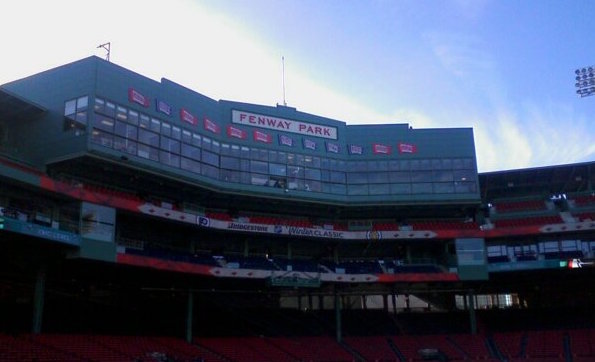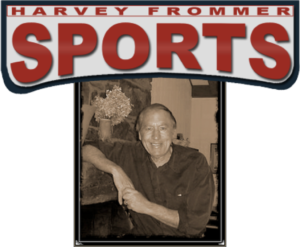
It was damp and chilly throughout New England for most of the spring of 1912, and in Boston, it took a few tries before baseball at a brand new ballpark could be played in decent weather.
On April 9th, the Red Sox and Harvard’s baseball team met in an exhibition game in football weather and as one who was there observed, “with a little snow on the side.” About 3,000 braved the elements. Boston won the game, 2-0 with both runs driven in by their pitcher, Casey Hageman.
The scheduled official Opening Day match on April 12th, however, was rained out. Finally on April 20th, the weather improved a bit, and Fenway’s first major league game: the Sox versus the Yankees (then known as the Highlanders), was set to be played before a crowd of 27,000 on soggy, lumpy grounds and infield grass transplanted from the Huntington Avenue Baseball Grounds, the team’s former home.
Boston Mayor John “Honey Fitz” Fitzgerald threw out the ceremonial first ball. The man, whose grandson would become the thirty-fifth president of the United States, was an ardent member of the “Royal Rooters” – a group of Red Sox fans who staged pre-game parades accompanied by the singing of “Tessie” and “Sweet Adeline.”
Ordinarily the game would have been the stuff of front-page headlines in New England dailies. Six days earlier, however, the largest passenger ship in the world had struck an iceberg and gone down in the icy waters of the Atlantic. The news of the sinking of the Titanic on its maiden voyage and the accompanying loss of 1,517 lives would eclipse all other stories.
Nevertheless, it was good news in Boston that the Red Sox finally had a modern ballpark. The original field that the team — then known as the Boston Somersets — played on was a former circus lot where sand covered much of the outfield and a tool shed sat in the middle of centerfield.
Owner General Charles Henry Taylor, a Civil War veteran and owner of the “Boston Globe,” had decided back in 1910 to build a new ballpark in the Fenway section bordering Brookline Avenue, Jersey Street, Van Ness Street and Lansdowne Street. It would cost $650,000 (approximately $14 million today), and seat 35,000. Ground was broken September 25, 1911.
An attractive red brick façade, the first electric baseball scoreboard, and 18 turnstiles, the most in the Majors, were all features being talked about. Concrete stands went from behind first base around to third while wooden bleachers were located in parts of left, right, and centerfield. Seats lined the field allowing for excellent views of the game but limiting the size of foul territory.
Elevation was 20 feet above sea level. Barriers and walls broke off at different angles. Centerfield was 488 feet from home plate; right field was 314 feet away. The 10-foot wooden fence in left field ran straight along Lansdowne Street and was but 320 ½ feet down the line from home plate with a high wall behind it. There was a ten foot embankment making viewing of games easier for overflow gatherings. A ten foot high slope in left field posed challenges for outfielders who had to play the entire territory running uphill.
This was the Opening Day Lineup for the 1912 Boston Red Sox.
| Harry Hooper | RF |
| Steve Yerkes | 2B |
| Tris Speaker | CF |
| Jake Stahl | 1B |
| Larry Gardner | 3B |
| Duffy Lewis | LF |
| Heinie Wagner | SS |
| Les Nunamaker | C |
| Smoky Joe Wood | P |
The Sox, with player-manager first baseman Jake Stahl calling the shots, won the game, 7-6, in 11 innings. Tris Speaker — who that season would bat .383, steal 52 bases and stroke eight inside-the-park home runs at Fenway — drove in the winning run. Spitball pitcher Bucky O’Brien was the winner in relief of Charles “Sea Lion” Hall. The first hit in the park belonged to New York’s Harry Wolter.
And that was how it all began.
BOOKENDS: Tom Yawkey: Patriarch of the Boston Red Sox by Bill Nowlin (University of Nebraska Press, $36.95, 531 pages) is a masterwork on the long-time BoSox owner that is long over-due. And Nowlin, whose resume includes almost 40 books on the Sox and a multitude of articles, has truly out-done himself.
Nowlin writes in his intro: “As I began to write a biography of Tom Yawkey, I was surprised to learn how little had ever been written about him.”
Now we have a lot written about the man who owned the team from 1933 to 1976. Complete, well written, filled with fascinating new information, Tom Yawkey: Patriarch of the Boston Red Sox is a must read for fans of the franchise and all those interested in baseball history. Warts and all Tom Yawkey and his time comes to life. HIGHLY RECOMMENDED
=============================================

Harvey Frommer is one of the most prolific and respected sports journalists and oral historians in the United States, author of the autobiographies of legends Nolan Ryan, Tony Dorsett, and Red Holzman, Dr. Harvey has been a professor for more than two decades in the MALS program at Dartmouth College, Frommer was dubbed “Dartmouth’s Mr. Baseball” by their alumni magazine. He’s also the founder of www.HarveyFrommerSports.com. His The Ultimate Yankee Book is available on Amazon or directly from the author.
